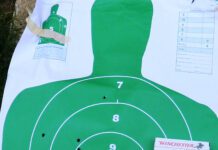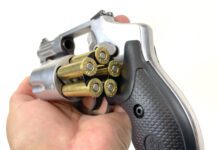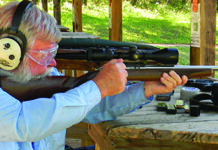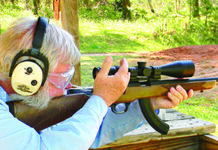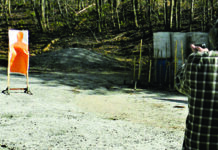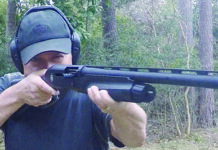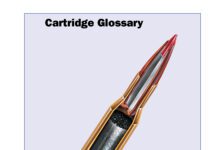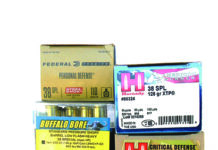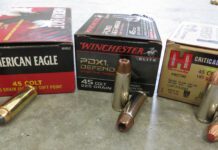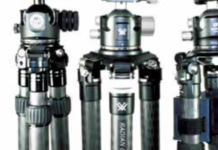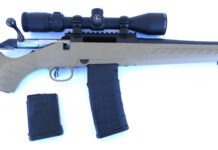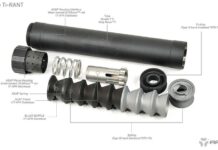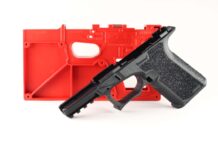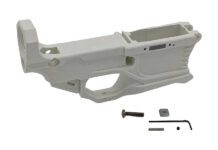S&W Bodyguards: Revolver Or Semiauto for Self Defense?
S&W Bodyguards: Revolver Or Semiauto for Self Defense?
Ruger or S&W Battery Mates: Which Would You Rather?
In this test we will evaluate two 6-inch heavy-barreled revolvers and two lightweight 2-inch-barreled revolvers, each paired by manufacturers. Both the $701 Ruger GP100 revolver KGP161 and the $829 686 Smith & Wesson 164224 feature stainless-steel construction, rubber grips, single- and double-action capability and weigh about 45 ounces. Both accept six rounds of 357 Magnum and/or 38 Special ammunition. Given their adjustable rear sights and generous sight radii, these guns were suitable for target competition as well as for self defense.
The little brothers were much lighter and slim enough to fit inside a pants pocket or purse. They were the $575 Ruger LCR LCR-BGXS with Hogue boot grip, and the $509 Smith & Wesson Bodyguard 38 103038, complete with built-in laser. Both of these guns were chambered for 38 Special, but similar models capable of firing the longer-cased 357 Magnum ammunition are available. Special features that make these revolvers similar were their lightweight alloy-and-polymer construction and fully enclosed "hammerless" firing mechanism, which made them snag-free and nearly impervious to being fouled by lint or other debris.
38 Special S&W Snubnose Showdown: Whos the Top Dog?
Three Stainless Snubbies: Wed Pass On Charters Undercover
Despite many competing autoloading pistols, the five-shot snubnose revolver still has lots of fans. In fact, some of those fans are among our test crew. Once limited to .38 Special, the snubby may now be found chambered in .357 Magnum. A small 2-inch revolver has a lot going for it in self-defense situations. Its irregular shape is often easier to conceal than the relentless slab of an autoloader. There are no magazines to fall out. As Elmer Keith put it, if you have any part of a revolver, you have it all. They are generally reliable for five shots, and can be recharged quickly with a speed loader. Despite what you see in the movies, most gunfights are over with the firing of only a shot or two. Though snubbies had pretty bad sights in the past, recent ones have excellent sights. The guns can be extremely accurate, though you may have to work to prove it. Of course a revolver will handle any level of ammunition, from primer-propelled wax bullets to the hottest loads. And there are no failures to feed. Not ever.
Many snubbies are made with hidden hammers, and we've looked at some of those over the past months, but it's been awhile since we looked at the old standby with its protruding, easily cocked hammer. These may not work all that well out of the pocket, but work fine from a holster. With fixed sights and a short sight radius, these are not among the best plinkers, but well suited for self defense. The three test guns we acquired were the Ruger SP101 ($530), the Charter Arms Undercover ($325), and the S&W Model 60 ($623). All three are stainless-steel five-shooters with fixed sights.
The Smith and the Ruger handle .357 Magnum ammo. For this test we chose the Charter Undercover, which is .38 Special only. Charter makes a .357 version called the Mag Pug, which is similar to the Smith and Ruger, but is much heavier than the Undercover and has a ported barrel which we didn't care for. So we gave the lighter Undercover a chance, with an eye toward easier carry. Because of the limitation of the Charter to .38 Special, we did most of our testing with .38 Special ammo, but did try some .357 loads in the other two. That doesn't mean we stuck with light loads. Far from it. Our most interesting test ammo was the heavy-bullet Buffalo Bore load designed to be similar to the old FBI round with lead bullet, but this time featuring a soft, Elmer-Keith-type, 158-grain cast hollowpoint lead SWC with a gas check to prevent leading. (See sidebar.) These loads are put together with flash-free powder, and gave little visible blast at night from these snubby revolvers. We also tested with Black Hills cowboy-level cast-bullet loads, with Winchester's Super-X 130-grain JHP, and — in the two .357s — Federal's Hi-Shok 130-grain JHP. Here's what we found.
Cowboy .38 Specials: EMF Is Our Pick, Ruger Gets A Buy Nod
Those who are most serious about Cowboy Action shooting tend to favor lighter-recoiling firearms so they can cut their times down, never mind that bigger guns like .45s tend to be more authentic, especially when stoked with black powder. Not that it takes any less skill to do well with lighter recoiling equipment, but it can give an edge, or so we've been told. This means .38 Special loads in handguns and rifles, and probably 20-gauge shotguns. How much benefit does a .38 Special offer over, say, a .45 Colt? There's a huge difference in recoil, even if the .45 shoots only light cowboy loads.
To find out more, we gathered a trio of .38 Special single-action six-shooters to see how well they'd do for us, and to find out how much we liked ‘em. All were .357 Mag-capable, and all had 4.75-inch barrels. The guns were a Ruger New Model 50th Anniversary Flat Top Blackhawk ($583), a Taurus Gaucho M38SA ($499), and from EMF Co., a resurrection of the old Great Western revolvers, the Great Western II "Californian" model ($450). We tested with three main types of ammo, Black Hills Cowboy loads, Federal 110-grain JHP .357 Mag, and with a modest handload in .38 Special cases that approximated Cowboy loads. Here's what we found.
Small-Frame Stainless .38s: Ruger, S&W Go Head to Head
No losers here: Ruger's KSP-821X and Smith & Wesson's 3-inch 60-15 are classics we wouldn't hesitate to buy. But Our Pick is the 5-inch S&W 60-18, a smooth, accurate, powerful gun.
Shrouded-Hammer .38 Special +Ps from S&W and Taurus
At only $461, we would buy the Taurus 851 SSUL ahead of the more expensive Smith & Wesson 638-3, $620. Reason: The Taurus has a nifty adjustable rear sight that adds versatility.
Super-Light Wheelguns for Self Defense: Too Much Power?
The guns in this test — Smith & Wesson's .45 ACP 325PD and .357 Magnum 327, and the Taurus .41 Magnum 451 — all have problems that would make us think twice before buying them.
.38 Special-Only Wheelguns: S&W Model 10 Is Nearly A 10
As a subscriber-supported publication, it is reasonable to believe that Gun Tests readers are passionate about guns. This means they have an active interest in collecting, shooting, participation in gun sports, and of course, self-defense. While it is easy to appreciate the most expensive firearms such as the Korth revolver (July 2002), each of us know that nearly any reliable handgun can be used to stop an act of aggression. In fact several people among our staff and associates became interested in firearms not from a family member nor via the NRA, but after playing the part of the victim wherein a handgun might have changed the outcome. It is easy to be reminded of this whenever we see a movie that begins with a horrendous or unspeakable crime against a defenseless victim. For example, in Jean Claude Van Damm's The Replicant, a serial killer enters the apartment of a young mother and brutally kills her. She is aware of his approach but does nothing. We find it amusing that this representative film and so many others could be shortened to approximately three minutes if the intended victim had merely lifted an unadorned .38 Special revolver and fired. But then we would have been denied the pleasures of so many more movies by the "muscles from Brussels."
Korth Combat Revolver, $4,700: The Ultimate Conditional Buy
At Gun Tests we often speak of features and modifications that push the performance of a given design further up the pyramid. What is this pyramid and why is it so important? Atop the pyramid is where all parts combine to produce the greatest possible results. Often the ability to climb the pyramid is linked directly to money. Most guns hover about midway up the pyramid in performance, function and appearance because they are priced in terms of available markets, i.e. your pockets and mine. But what if a firearm was produced without a price point in mind? How much would such a gun (in this case a 4-inch combat revolver) cost?
Steel Snub-Nosed .38 Specials: Taurus is Good, but Smith is Better
The five-shot snubbed-nosed .38 Special revolver is a traditional backup gun, but recent trends have tended to favor aluminum and titanium featherweights instead of steel-framed models. But steel still has its appeal, and we wanted to go back to earlier wheelgun versions to see what first made them favorites of couriers, detectives, and regular joes fifty years ago.
For this comparison, we chose two standard steel guns in .38 Special, the Taurus 85, $286, and S&W's $539 small-frame 36LS LadySmith, marketed to women, as its name suggests. But we paid no attention to that market positioning, because we've handled the LadySmith and knew its handling was on par, or perhaps better, than other boot-size guns pitched to men. Our thinking: From the muzzle forward, a bad guy can't tell the difference.
Also, with recent memories of testing featherweight titanium revolvers in mind, we wondered how much porting would affect felt recoil, and toward that end we also acquired a Taurus 85 with a ported barrel, $305. By comparing Taurus's standard barrel to the ported model, we hoped to find if we were willing to spend more time practicing with it than not.


